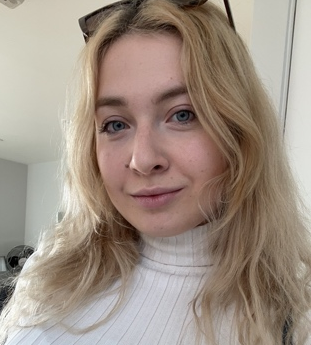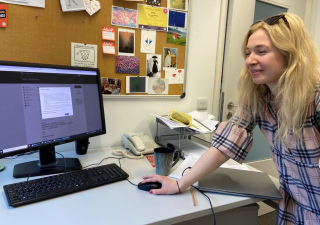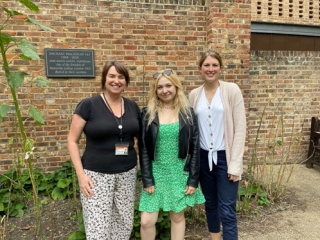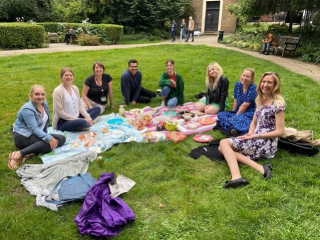My First Steps as a Researcher | EPS-funded summer project at the LiLaC Lab
Summer student Maria Jelen, detailing experiences from her first steps into the world of researching!

This past summer, at a time of changing restrictions and global uncertainty, I was fortunate enough to have the fascinating opportunity to focus my attention on a completely different type of unpredictability – research. This is the story of my first independent project titled “The role of language in mental health during the transition from primary to secondary education”, completed under supervision of Dr Sarah Griffiths and Prof Courtenay Norbury, funded by the Experimental Psychology Society Undergraduate Research Bursary.
The aim of the project was to find if mental health (specifically anxiety and depression) changes between Year 6 and Year 8, and if this change is predicted by earlier childhood language, measured in Year 1. We also attempted to assess how these mental health symptoms vary for children with and without language disorder (LD), who may be facing different social and academic challenges to children with typical language; and if these social experiences possibly mediate how language affects mental health. Finally, as an exploratory analysis, we wanted to see if children assessed during the Covid lockdown had poorer mental health than those seen before.
My first task in the lab was a deep dive into the literature, to establish what is already known about mental health in early adolescence and what factors contribute to the frequently observed emergence of symptoms at that time (Kessler et al., 2005). I specifically focused on children with language disorders, especially DLD, and how they seem to be experiencing more social difficulties like bullying (Conti-Ramsden & Botting, 2004) or poorer quality friendships (Fujiki et al., 1996) compared to typically-developing children; possibly leading to increased mental health problems (Durkin & Conti-Ramsden, 2007).
Once we established the main focus of the project and set out our research questions (and trust me when I say – we considered innumerable perspectives and ideas!), the next step was choosing appropriate variables from the vast SCALES dataset and constructing analytical models we could utilize to test our hypotheses. I was very glad I paid attention in my statistics course – we decided to use various multivariate models, including Linear Mixed Effects and Structural Equation Modeling (which I had never seen before!). It was at this stage that I gained experience in coding in R – I learned the benefits of writing out code for analysis in advance and testing it on simulated data, so as to have a working script ready for when the real data is accessible. Besides learning more of the R language, most importantly I gained confidence and passion for coding and I have since been able to implement what I learned in other research projects!
We really wanted to ensure high quality and transparency of our research (no HARKing!), so all analysis models were coded beforehand in R and then I preregistered our study on the Open Science Framework (https://osf.io/yg2wf). This was a key objective of my learning – the new experience taught me how elaborate and difficult registering a research study is, as everything needs to be thought of in advance; however, I also learned the value of preregistration and was very glad to be contributing to open, reproducible science.

After successful preregistration, the big day finally came – I was granted access to the data! With everything having been preregistered and prepared before, after some initial wrangling I was able to get first results within just a few productive days. The surprising nature of some of our findings showed me exactly why research is so fascinating – all the hypothesizing and planning in the world will not replace the role of evidence, which may turn out to be different than anticipated. What followed was the meticulous process of evaluating possible explanations and troubleshooting within both the methodology and analysis to ensure we indeed captured what the data was telling us. The final step, which is ongoing, was to elegantly report the findings in the form of an article, which can hopefully be submitted for publishing in the near future.
Throughout my time in the lab, I also had a variety of other enriching experiences. I was able to attend weekly meetings, where I could learn how to present results and critically review both my own and others’ findings. By observing researchers at work, as well as doing small tasks for other projects, I was able to gain insight into how a lab group functions and how people with various focuses and career experiences can support each other to produce well-rounded and nuanced research. Most recently, I learned how to submit a poster presentation to a conference, which I hope to attend to present my results.

This fascinating research project and nurturing supervision meant that I was constantly challenged to learn new skills and work independently, but I was also guided and supported by experts I could look up to – but also have some tea and cake with J! I could not imagine a better place to make my first steps as a researcher, and I can say now that they most certainly won’t be my last!
Acknowledgements
 This project would not have been possible without the fantastic people I met in the LiLaC lab, who all contributed to the greatly productive and enjoyable time I had. First and foremost, I would like to thank Sarah for your tireless help, R-hacks, patience for my many, many questions and your endless creativity; and Courtenay, for your time, support and feedback, fascinating insight, tastiest treats and leading the friendliest and supportive lab I have ever heard of! I would also like to thank Laura, the most organized person I know, for your help and laughter; and thank you to Jo, for your support and invaluable R help, from my first ever R tutorial completed on your laptop to coding moderated mediation SEMs! Finally, thank you to Disa, Sid, Ria and Maria for all your kind words and great times we had in lab meetings and socials!
This project would not have been possible without the fantastic people I met in the LiLaC lab, who all contributed to the greatly productive and enjoyable time I had. First and foremost, I would like to thank Sarah for your tireless help, R-hacks, patience for my many, many questions and your endless creativity; and Courtenay, for your time, support and feedback, fascinating insight, tastiest treats and leading the friendliest and supportive lab I have ever heard of! I would also like to thank Laura, the most organized person I know, for your help and laughter; and thank you to Jo, for your support and invaluable R help, from my first ever R tutorial completed on your laptop to coding moderated mediation SEMs! Finally, thank you to Disa, Sid, Ria and Maria for all your kind words and great times we had in lab meetings and socials!
References
- Conti-Ramsden, G., & Botting, N. (2004). Social Difficulties and Victimization in Children With SLI at 11 Years of Age. Journal of Speech, Language, and Hearing Research, 47(1), 145-161. https://doi.org/doi:10.1044/1092-4388(2004/013)
- Durkin, K., & Conti-Ramsden, G. (2007). Language, Social Behavior, and the Quality of Friendships in Adolescents with and without a History of Specific Language Impairment. Child Development, 78(5), 1441-1457.
- Fujiki, M., Brinton, B., & Todd, C. M. (1996). Social Skills of Children With Specific Language Impairment. Language, Speech, and Hearing Services in Schools, 27(3), 195-202. https://doi.org/doi:10.1044/0161-1461.2703.195
- Kessler, R. C., Berglund, P., Demler, O., Jin, R., Merikangas, K. R., & Walters, E. E. (2005). Lifetime prevalence and age-of-onset distributions of DSM-IV disorders in the National Comorbidity Survey Replication. Arch Gen Psychiatry, 62(6), 593-602. https://doi.org/10.1001/archpsyc.62.6.593